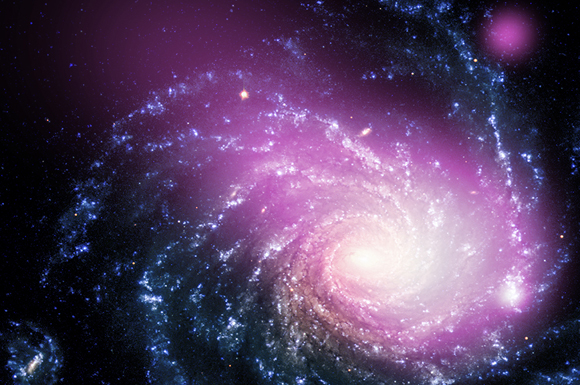
If the majestic pinwheel structure of this galaxy wasn't beautiful enough, the pink halo gives this photograph a magical finish. Yet, what we're actually seeing here is pretty violent. In this picture, a galactic collision is taking place between the grand spiral galaxy and the tiny dwarf galaxy that you can see to its right. The pink mist is actually a huge cloud of gas, burning at millions of degrees Celsius, which forms when these galaxies clash! This cloud is mostly invisible to our eyes but the gas shines brightly with high-energy X-ray light at extremely high temperatures.
Near the "head" of this comet-shaped fog, you can see an area with a group of very bright stars. The energy of the crash may have caused a boom of star formation here. Powerful explosions from dying stars and gale-force winds coming from hot, bright stars help keep the cloud shining brightly with X-rays.
As for how big this cloud is, it's difficult to measure. We struggle to determine the shape of distant cosmic objects. We only have flat, 2-dimensional images to work with and it's not like we can fly behind them to take a look! Is this pink mist thin and shaped like a pancake? Or is it thicker, like a fat rain cloud? Until we know the shape, we can't be sure just how big it is. If it is thin like a pancake then it will have 40,000 times the mass of our Sun. If it is more spherical, it would be more like 3 million times as massive as our Sun!
Cool fact: When a crash happens on Earth, between two cars for example, it's all over in a explode-second. But a collision between two galaxies happens in slow motion, dragging on for millions of years. Astronomers guess that this impact will stretch on for 50 million years!
Watch the video podcast
Do you want to learn more about this topic?
Visit the Chandra field guide or send us your questions in an email: cxcpub@cfa.harvard.edu
In cooperation with Space Scoop: Bringing news from across the Universe to children all around the world. Universe Awareness and the Chandra X-ray Observatory
| Children & Online Privacy |



